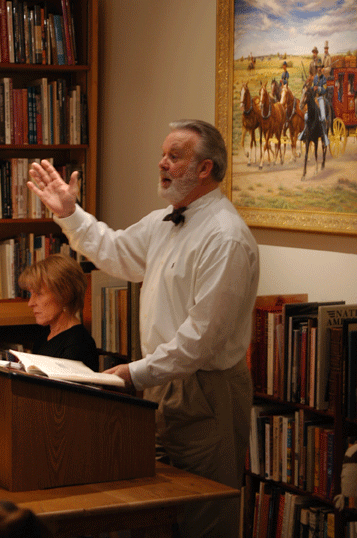Postscript to a Remarkable Sale
- by Bruce E. McKinney

Doug Johns at the podium.
By Bruce McKinney
On December 2nd in the minutes leading up to the 10:00 am start of the auction of Glen Dawson's Los Angeles Imprints, 1843-1873 at Johns' Western Gallery in San Francisco, bidders were busy trying to be inconspicuous in a space not much larger than a hotel coatroom. Eight men and one woman completed their sign-up paperwork, looked once more at the small but exquisite collection of LA-iana and selected seats with unobstructed views of auctioneer Doug Johns who looked trim and confident. A few bidders, in paranoid preparation, identified to the auctioneer their bidding signals; the hand at the chin, the crossed leg and glasses suspended as waving your paddle is now out-of-fashion. Among the would-be bidders muted hellos punctuated the now funereal quiet. On the auction house books were the hopeful contributions of the soon to be disappointed. As well, others sat by phones waiting to be called: they the trial by fire optimists or judicium Dei. This would not be their day either. Promptly at 10:00 am a call was placed to an unidentified bidder who now prepared to pluck the wings of the assembled aspirants. The auction lacked only the plate over the door that reads "Abandon hope all ye who enter here."
The material was undeniably good and impossibly uncommon and the venue entirely appropriate: 250 Sutter, a street named for John Sutter of Sutter's Mills where gold was discovered in 1848. On this day gold was about to be rediscovered. "What am I offered for lot one, a holograph document dated 1843 with the hand stamp 'Prefectura Politica Los Angeles' and estimated at $2,000 to $3,000?"
In the next moment silence ensued and hope, the heroin of the auction addicted, surged into a 4th of July fireworks of expectation. "Will we steal today?" The moments ticked by, the thump of heartbeats resonating in every bidder's breast. No one offered half the low estimate and Mr. Johns accommodated the hopefuls by dropping the opening bid until the contest was joined at $250. He then turned to the woman now speaking with her bidder by cell phone who, after a pause, signed "yes". In baby steps the bid then advanced, the high estimate breached only in the second minute. This lot, the earliest Los Angeles item in the sale, brought $5,175, well above the $3,000 high estimate. One hundred and twenty seconds earlier it had looked like a beggar on the church steps.
Items 2 to 11 went the same way, all to the phone bidder. Each item found an opening bid only after Mr. Johns lead the aspiring buyers so deep into the catacombs of the dead and dying that recovery to any reasonable level seemed impossible. And each time, like Lazarus, the bids slowly rose, the items that a minute before were unwanted, now moved beyond the low estimate to higher ground. Item eight, an 1852 California Census printing in Spanish with a Streeter provenance, in this way struggled first to find support at $250 against a low estimate of $700 before heading off to another solar system altogether to sell for $14,950.